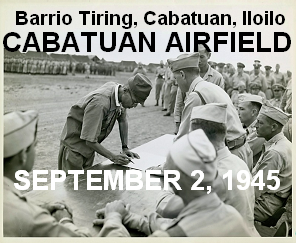
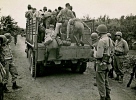
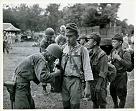
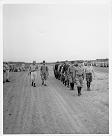
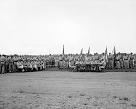
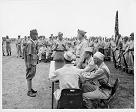
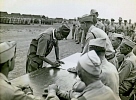
Col. Ryoichi Tozuka signs the surrender instrument
as Col. Raymond G. Stanton looks on.
Cabatuan Airfield
Barrio Tiring, Cabatuan, Iloilo
Panay Island, Philippines, September 2, 1945
|
|
- o -
|
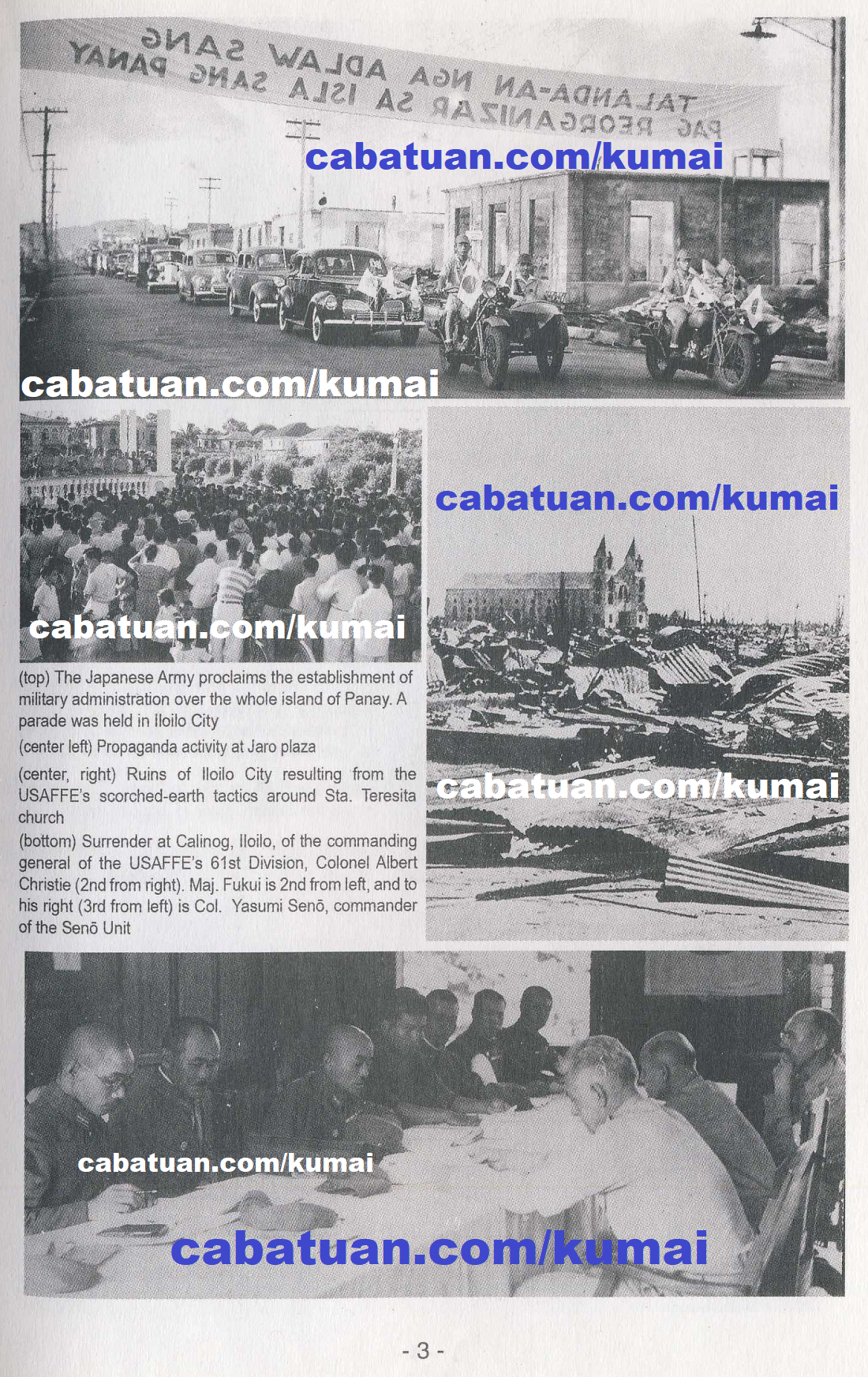
(top) The Japanese Army proclaims the establishment of
military administration over the whole island of Panay. A
parade was held in Iloilo City
(center left) Propaganda activity at Jaro plaza
(center, right) Ruins of Iloilo City resulting from the
USAFFE's scorched-earth tactics around Sta. Teresita
church
(bottom) Surrender at Calinog, Iloilo, of the commanding
general of the USAFFE's 61st Division, Colonel Albert
Christie (2nd from right). Maj. Fukui is 2nd from left, and to
his right (3rd from left) is Col. Yasumi Senô, commander
of the Senô Unit
|
|
3.3 Hamletting
Around April of 1943, following the suggestion of Captain Kengo Watanabe, the strategic villages system (i.e., hamletting or zonification) was introduced into the plains of Iloilo. This had been the practice by the Japanese Army in Manchuria, also later used by the US Army in the Vietnam War.
Certificates known as the cedula were issued to civilians in villages under Japanese Army control to distinguish them from villagers under guerrilla control. Mindful of the power balance between the guerrilla and the Japanese Army, some locals moved to what seemed to be safer areas. Of course, that was only a superficial allegiance and most of these villagers offered information to help guerrillas; some even led guerrillas into the strategic villages.
It might have appeared that the strategic villages were under Japanese control, but in reality, the guerrillas controlled most of them. People simply stayed in those villages because it was safe with the Japanese soldiers’ presence at night. We asked them to let us know as soon as a guerrilla entered the village, but no such news ever came in. The guerrillas and residents of the strategic villages were relatives and friends; they all held grudges against the Japanese Army that had brought on all the chaos in their lives since the invasion.
In consideration of the other villagers, guerrillas who entered the strategic villages did not attack nor commit acts of terrorism. However, they threatened Japanese soldiers in different ways. In one instance, a Japanese soldier went to a small beverage stand in Pavia where his favorite lovely girl sold tuba (an intoxicating drink from coconut sap). When he returned to the garrison, he suffered an awful pain and died. When his companions went to investigate, the stall and the girl were gone.
Guerrillas also used land mines and dynamite to blow up the trucks and cars of the Japanese Army. The tread of a tank of the Maeda platoon was blown off. Guerrillas sent in arsonists as well into the city. Even women and children were involved in setting off explosives and starting fires. The fires that broke out at night appeared to be signals for guerrillas to attack Japanese facilities, including the headquarters. They did these attacks to remind everyone of their existence. However, they also made city residents anxious, causing many to evacuate elsewhere. Tasked to bring back peace and order, the Kempeitai sought out the arsonists and dispatched scouts every night to prevent these guerrilla activities. Captain Watanabe also dispatched a nightly squad of scouts.
The guerrillas, however, were well aware of their activities. They attacked and killed the scouts one after another. Therefore, Watanabe decided to use Filipino spies to collect information. Among them were a few former thieves and criminals as well as some POWs who cooperated for fear of their lives. At first, as soon as they brought information, soldiers and kempeis went out disguised as locals and arrested some guerrillas. However, local citizens despised those spies who worked for the Japanese and this made it difficult for the Japanese to get useful information. Moreover, some of the spies took advantage of Japanese support by robbing decent citizens of money and other articles. Occasionally, taking liberties during an official search, they stole and even raped women, thus eroding the people’s trust in the Japanese Army.
Naturally, the guerrillas brutally punished the spies who worked for the Japanese, killing quite a number of them. Some went missing. Others had to work for the guerrillas by counter-spying on the Japanese. The ‘Spy Game’ was in total confusion, but there were indeed some spies whose work for the Japanese Army produced some results.
Whatever information he got, Captain Watanabe reacted at night, arresting suspects and detaining them in the locked cell at the basement of the Iloilo High School headquarters. There were always about 30-40 suspects cramped inside the jail cell and the accompanying investigation was extremely cruel. Suspects were beaten with bats, forcibly filled with water until their stomachs swelled, causing them to yell and shout all day. When they gave out information, Captain Watanabe forced them to show the way on nighttime searching trips. The suspects knew this and so endured the torture as long as they could. The ones released were those who revealed the correct information that led to the capture of new guerrillas. Then, the guerrillas captured and executed them in retaliation. Some who served the guerrillas did so to avoid their sanctions, or else, to exact revenge. Thus, they led guerrilla attacks on the garrison or other facilities of the Japanese Army.
The prison was so full that there was no space to lie down. Since it was impossible to detain many guerrillas or to spare enough guards, Captain Watanabe had to release the guerrillas and suspects he had arrested. However, once released, they not only gave information to the guerrillas but also led the attacks of the guerrillas on the garrison. Eventually, therefore, the Intelligence Section started to execute the guerrilla suspects.
Japanese soldiers who had witnessed the terrible deaths of their close friends slain by the guerrillas became anxious and terrified, fearing a similar fate. They changed their opinions and resolved that they should kill guerrillas before they got themselves killed.
Among the Japanese soldiers was a former Buddhist monk around 30 years of age, who always recited Buddhist sutra (prayers) after each execution. But when his comrades were killed one after another, even he started saying, ‘Unless we kill them, we will be killed,’ and became indifferent of the execution of the guerrillas.
The retaliation of the guerrillas also got more and more brutal. In the hatred generated by these circumstances, the guerrillas and the Japanese as well had forgotten the noble causes of ‘Defense of My Country’, ‘Holy War’, and ‘Greater East Asia Co-Prosperity Sphere’. Each side tried to kill as many enemies as possible, and Panay became an island of murder and slaughter. On both sides, there were extreme unnatural behaviors that were beyond common sense.
During the propaganda and pacification campaigns, the captured guerrillas as POWs were all released after a short period of imprisonment with propaganda leaflets and other goods. Some guerrillas made themselves easy captives knowing that they would soon be set free, making use of the situation to obtain more information on the Japanese Army. Some released POWs became guerrillas once again because they could not get a job or food in areas controlled by the Japanese Army. As a condition for taking them back, they were forced to supply the guerrillas with some information on the Japanese or lead attacks on Japanese facilities or barracks. Surprise attacks often led to many Japanese casualties.
Within the Japanese Army, some called for measures that were more stringent. There were observations of some local residents that Japanese ways were more lenient than American suppression of guerrillas at the turn of the century when the US Army occupied the Philippines. These advocates argued that our ways then would not be able to subdue the Panay guerrillas who were the most dauntless of all in the Philippines. Captain Watanabe eagerly studied the US Army annihilation strategies in the Philippine-American War in 1899, and the results were evident in the later subjugation of the guerrillas.
|
|